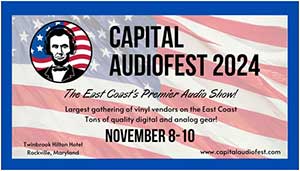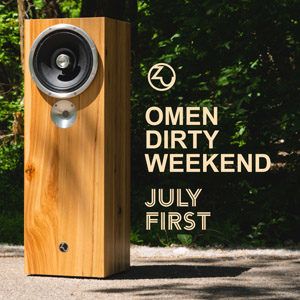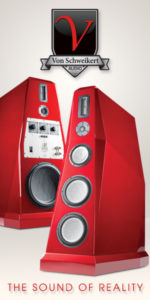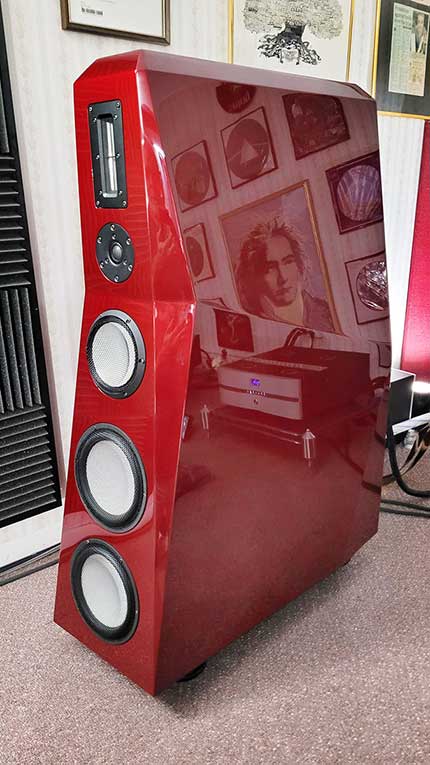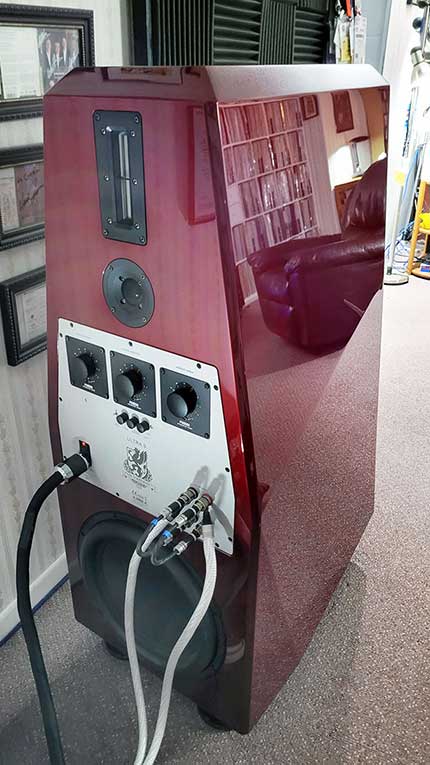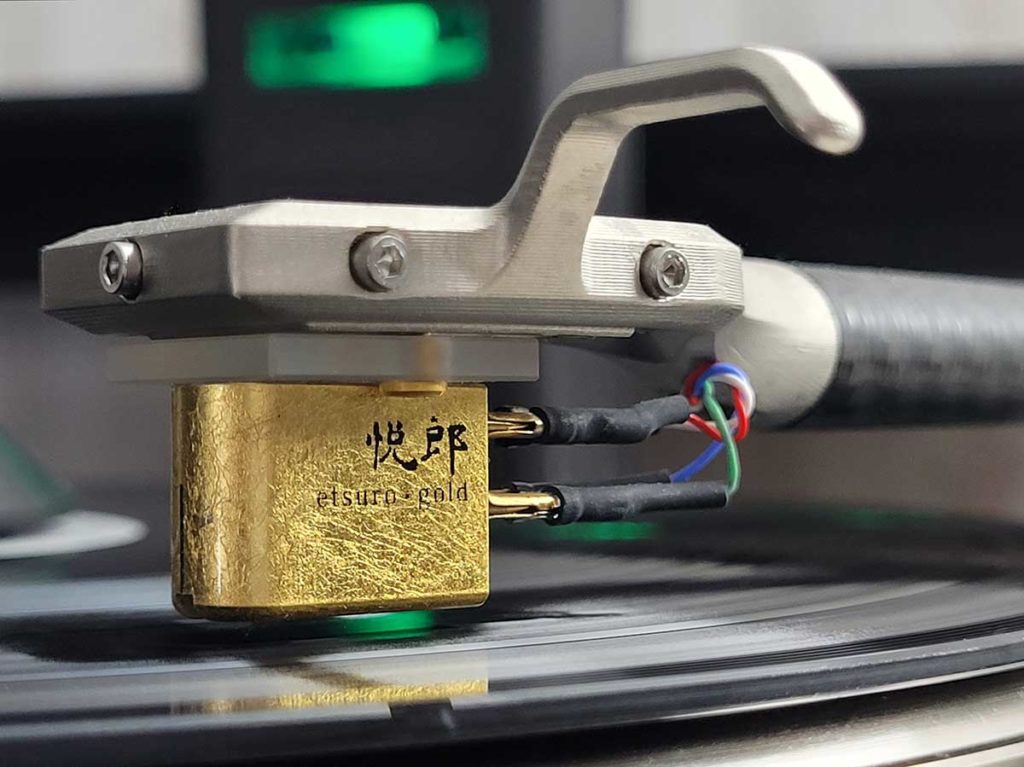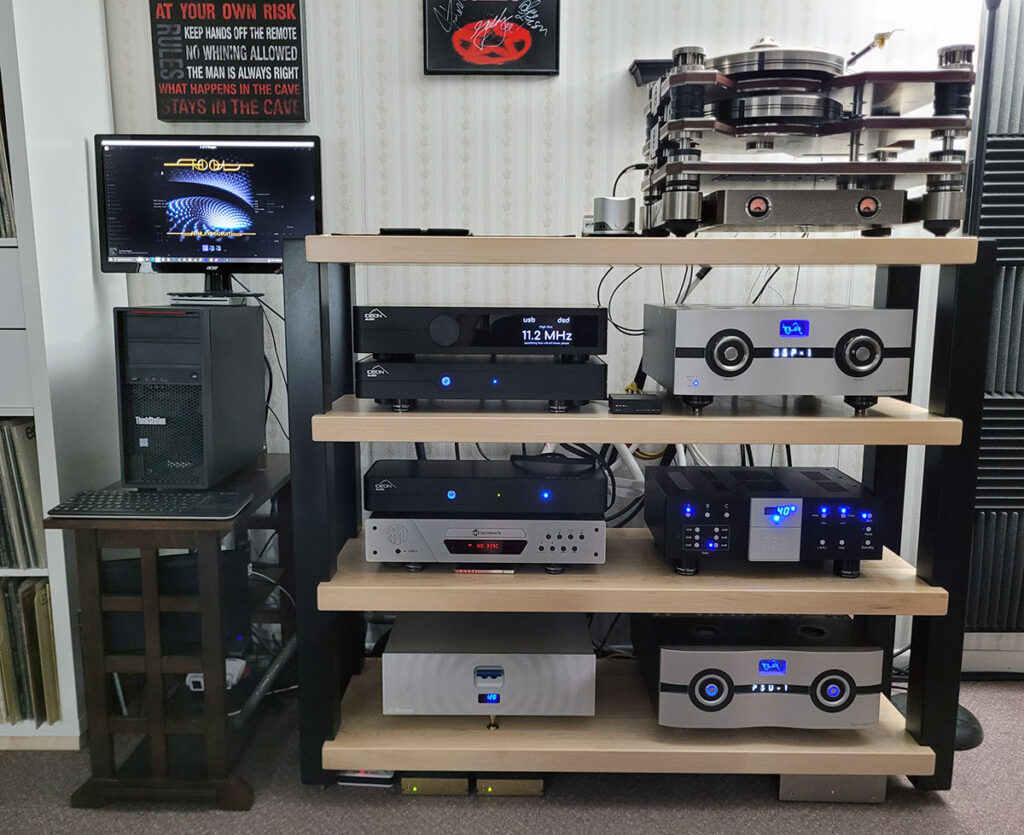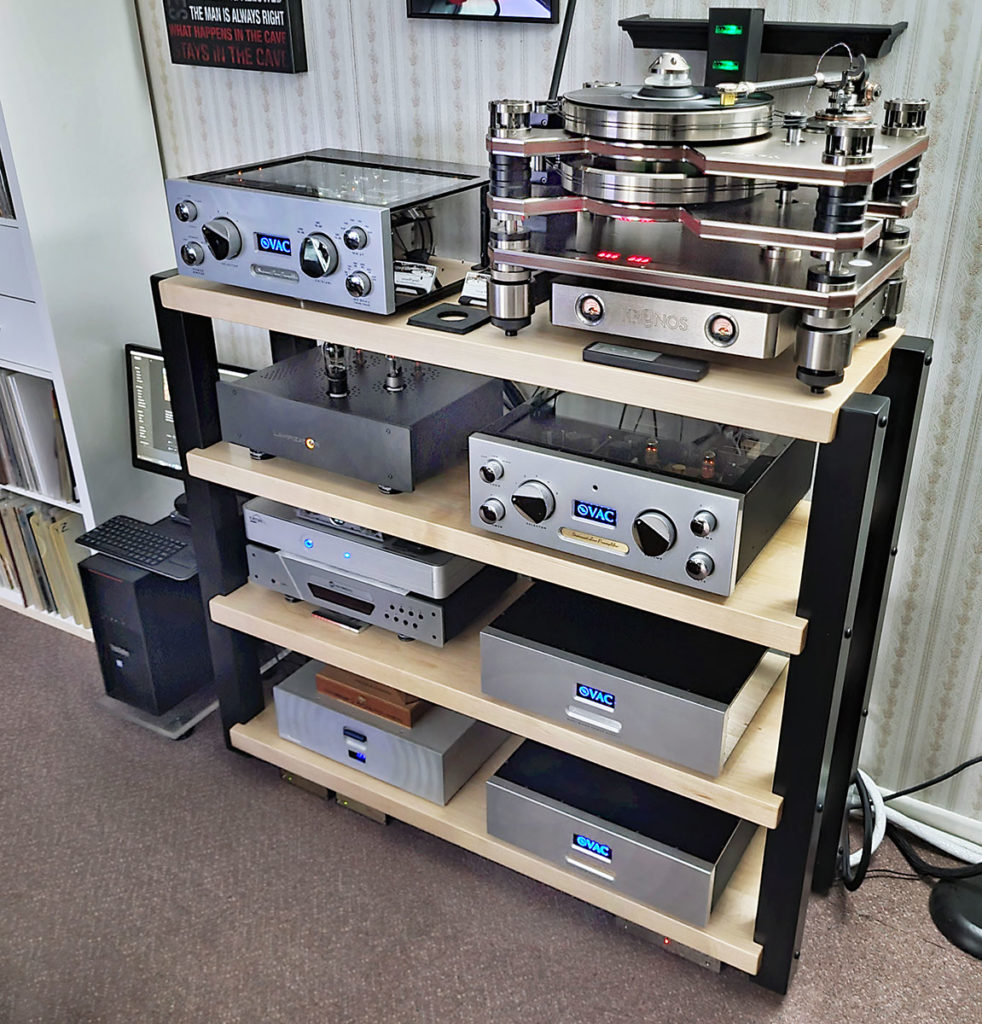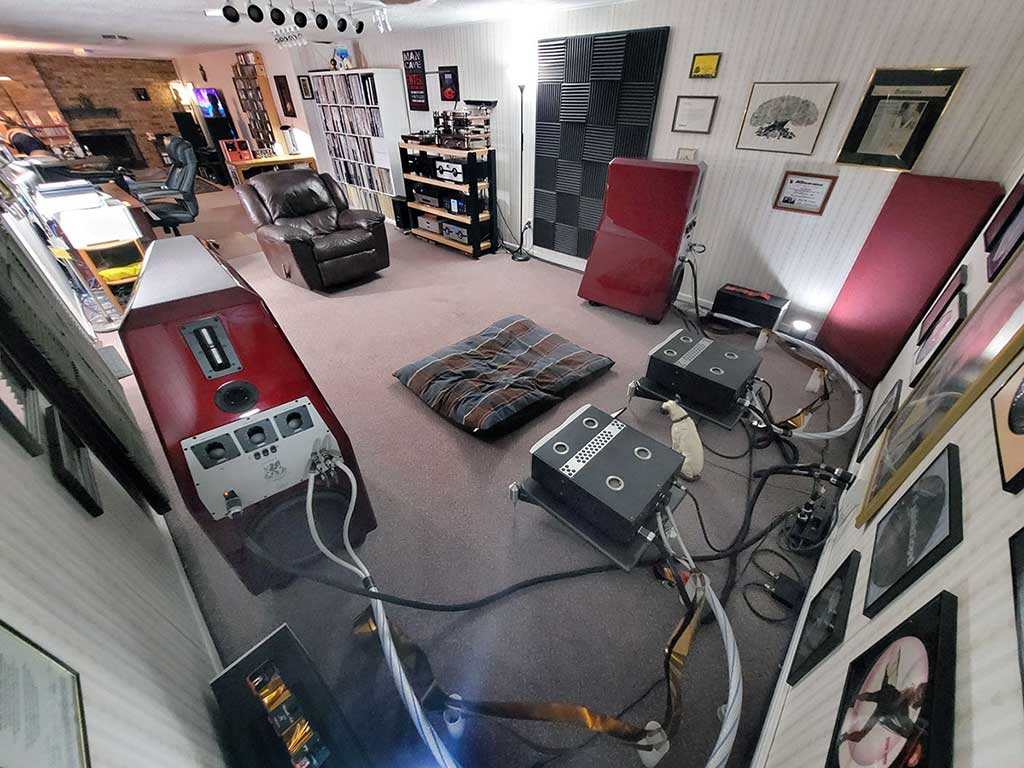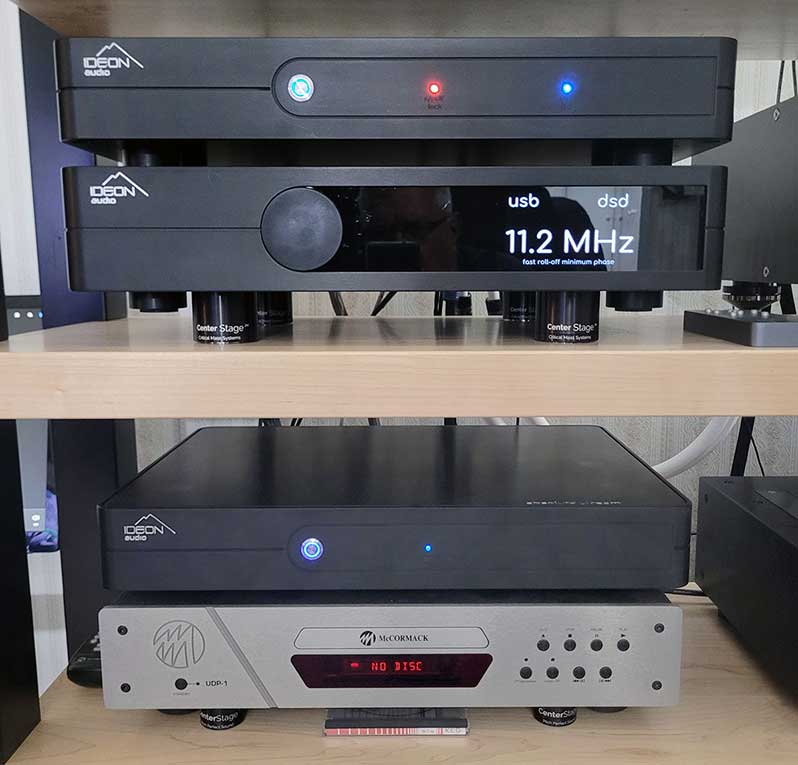
My Reference Music System
This is the gear against which all review
and audition components are compared …
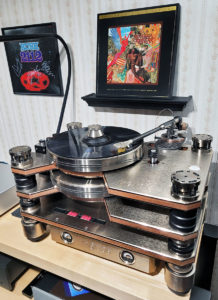


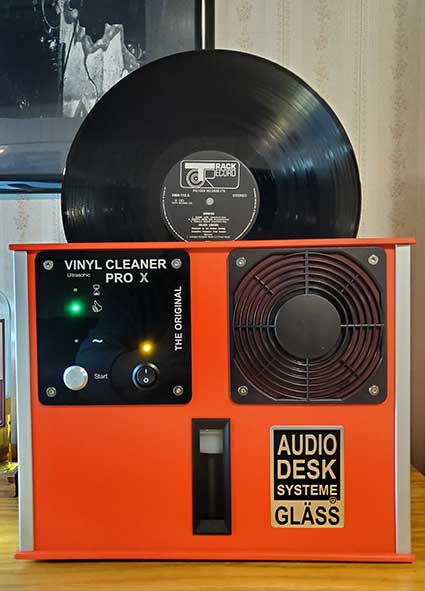


the audio analyst©
Current System configuration
For a tour of many of my previous systems,
going back to the late 1980s, follow this link
Bill Parish, of GTT Audio & Video, shares a
video visit to my listening room– June 23, 2020
Take a tour of the audio analyst© listening
room with Bill Parish, of GTT Audio

Below is a scale drawing followed by a comprehensive description of my reference listening space
 In November 2015, with the kids grown and out of the big 5-bedroom, 3-floor house, we moved to a smaller home situated on nearly two acres in north-west Goshen, IN. My new music room occupies the north end of the west half of my basement, in a room that is 46′ X 13′ x 7′ 4″. Further, I have two different sized and asymmetrically placed doorways opening into another equally sized space, one that is 40″ wide by 78″ tall, starting 11′ 10″ from the front wall, another that is 34″ wide by 77″ tall, starting 28 feet from the front wall, both of which act as aperiodic vents. This large space also houses my small theater at the south end by the fireplace.
In November 2015, with the kids grown and out of the big 5-bedroom, 3-floor house, we moved to a smaller home situated on nearly two acres in north-west Goshen, IN. My new music room occupies the north end of the west half of my basement, in a room that is 46′ X 13′ x 7′ 4″. Further, I have two different sized and asymmetrically placed doorways opening into another equally sized space, one that is 40″ wide by 78″ tall, starting 11′ 10″ from the front wall, another that is 34″ wide by 77″ tall, starting 28 feet from the front wall, both of which act as aperiodic vents. This large space also houses my small theater at the south end by the fireplace.
Some quick calculations reveal the room is about 600 ft2 or some 4300 ft3. Based on room length, it can support full development of frequencies down to about 24Hz, with primary axial resonances at about 44Hz and 78Hz. But the room is amazing sounding, and exhibits remarkably little loading. In fact, during a visit to install and set up my Von Schweikert Audio ULTRA 9 loudspeakers, Leif Swanson, Chief Designer at Von Schweikert Audio said, “You seem to have some pretty cool things taking place with the room. Good length for the bass waves, and those doorways. I notice very little change to the bass walking around the room. You definitely scored with this room.”
Because I began programing in 1971 while a sophomore in high school, and just recently (November 2021) retired as IT Engineer/Analyst who is certified on both Microsoft and Apple platforms, I’ve chosen to build my own Windows based PC as a file server/Streamer. I started with a Lenovo ThinkStation P320 CAD Workstation with an Intel® Xeon® 3.50GHz quad core CPU running 8 Logical Processors, with 32 GB RAM, and I use a Samsung EVO Plus solid-state drive for the OS.
The computer is further optimized for playing music by using Fidelizer 8.10 (https://www.fidelizer-audio.com/), an installed utility that allows leveraging, managing, and prioritizing a computer’s core functionality, services, and processes. My primary streaming and music management software is Roon 2.0, but I also employ J River MediaCenter 31. The files are transferred from my Media Server to either of my two digital playback systems (either the Ideon Absolute Suite, including the Absolute Stream streamer, the Absolute Time reclocker, and the Absolute Epsilon DAC, or the overachieving LampizatOr Baltic 4 DAC), by means of a STEALTH USB-Select-T (a tunable USB cable!), or an Audience frontRow USB cable. Given the way most DACs see DSD files, I have found USB connectivity to be the most effective overall.
Files are then served from my Buffalo LS220D 12TB Network Attached Storage system using sonically chosen Cisco router systems and switches, and all Audience Hidden Treasure Ethernet CAT7 cable. I have also installed the Hidden Treasure SATA cables inside the Workstation. The results are extremely effective.
The tweeters of my Von Schweikert Audio ULTRA 9’s are centered 1′ 10″ from the sidewalls, and 7′ from the wall behind them, with a toe in of about 8 degrees. The prime listening area is centered roughly 12′ back from the plane of the tweeters. This placement puts the back of the markedly deep enclosures, and their unique-to-the-industry, room-integrating rear-firing Ambience Retrieval System, 4’ 10” away from the front wall.
The ULTRA 9s, at just over five hundred pounds each, have a sensitivity of 92dB @ 1w/1m, a remarkably stable 4 ohm nominal impedance, and offer an in-room frequency response of 16Hz-40KHz. With their internal 1000-watt mono amplifier and the fully integrated suite of controls for their rear-mounted 15’ subwoofer (you can control amplitude, crossover frequency, and fully variable phase, from 0 to 180 degrees), combined with my Audionet Max monoblocks output of 700 watts into 4 ohms, gives me some 3400 watts of power. Not only does this mean that my system will likely never run short of current or clip, but it means that I can measure my system’s output in horsepower! Since 745.7 watts equal 1 horsepower, I have just a tad under 4.6 horsepower!
In addition to the native positive attributes of my listening room mentioned above (dimensions and aperiodic venting), further room taming is achieved with the use of RoomTunes Corner Tunes, two Echo Tunes (one each at the tweeter’s primary reflection points on the ceiling), and the remarkably effective and affordable ATS Acoustics Corner Bass Traps in each corner behind the speakers. Two 6-foot-tall by 4-foot-wide panels of Auralex Studiofoam Wedgies provide absorption (and a bit of diffraction as well) at both the first and second side-wall reflection point for the speakers.
And while the subtly perceptible contributions made by the Shakti Innovations Hallographs are significantly more apparent in smaller or irregular shaped rooms, in my larger room now (46’ by 13’), they don’t have the same impact on tonality, but they do still shed better illumination into the rear-most corners of the soundstage. So, IF you are buying used, or getting a great deal, they ARE worth a try. I think that they provide enhancements that you cannot duplicate any other way.
Power to components in the listening room is fully dedicated, with a separate 20-Amp service run from the panel for the amplifiers (main audio and subs), and another separate 15-Amp service run for the sources and other electronics. All other devices on that level of my home (computers, lights, printers, televisions, heating/AC, etc.) are on separate, isolated circuits. At the time the new services were run, I also had the whole home grounding system redone, including the installation of new grounding rods, in order to both comply with the current National Electrical Code standards of achieving A resistance of 25 ohms or less, and so as to not introduce any unnecessary noise into the power delivery system, in an attempt to provide the highest degree of sonic accuracy possible, ensuring the blackest of backgrounds, improving the pace, rhythm and timing, and painting a wider, deeper, and taller soundstage, including better separation of vocals and instruments.
Those who know me (or have read my work over the years) know that my system MUST be tonally accurate, strikingly neutral, stunningly transparent, and jubilantly musical. However, open, detailed, and layered soundstaging, combined with realistically sized and spatially accurate images, are every bit as important to me as truthful timbre and musical bloom. With the right recording, this system whisks you back to the venue or hall of the original performance for a spooky-real recreation of that event in the here and now.
I have had any number of audiophile and musician visitors’ remark on the power of the listening experience as witnessed from my chair. Musicians from any number of genres of music, from Salsa to Rock ‘n’ Roll to Classical, have actually wept after or during a listening session, and audiophiles of many years have remarked things like, “What more could you ask for,” and “I’ve never heard a rig sound ANY BETTER than this.”
While those are encouraging words, and seem to indicate that I’m doing the right things with component and cable selection as well as room set up, my system (every system? ;-D) must be seen as an ongoing work-in-progress. Every once in a while, the addition of some new piece, be it a source, a cable, or an accessory, allows me to move just a little closer to that actual musical event. The journey continues….
Care to do some time traveling? Here is a link to many earlier systems



